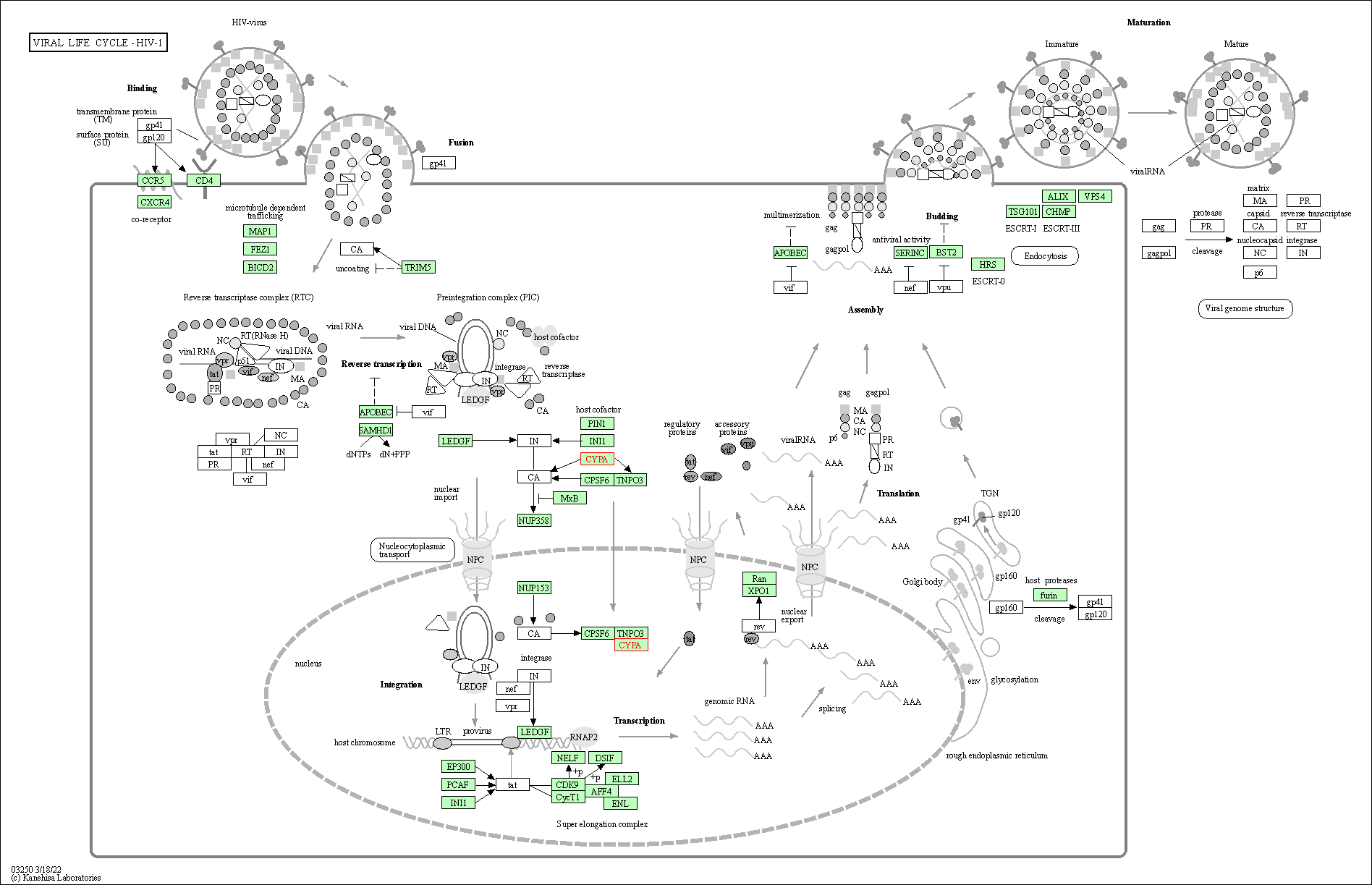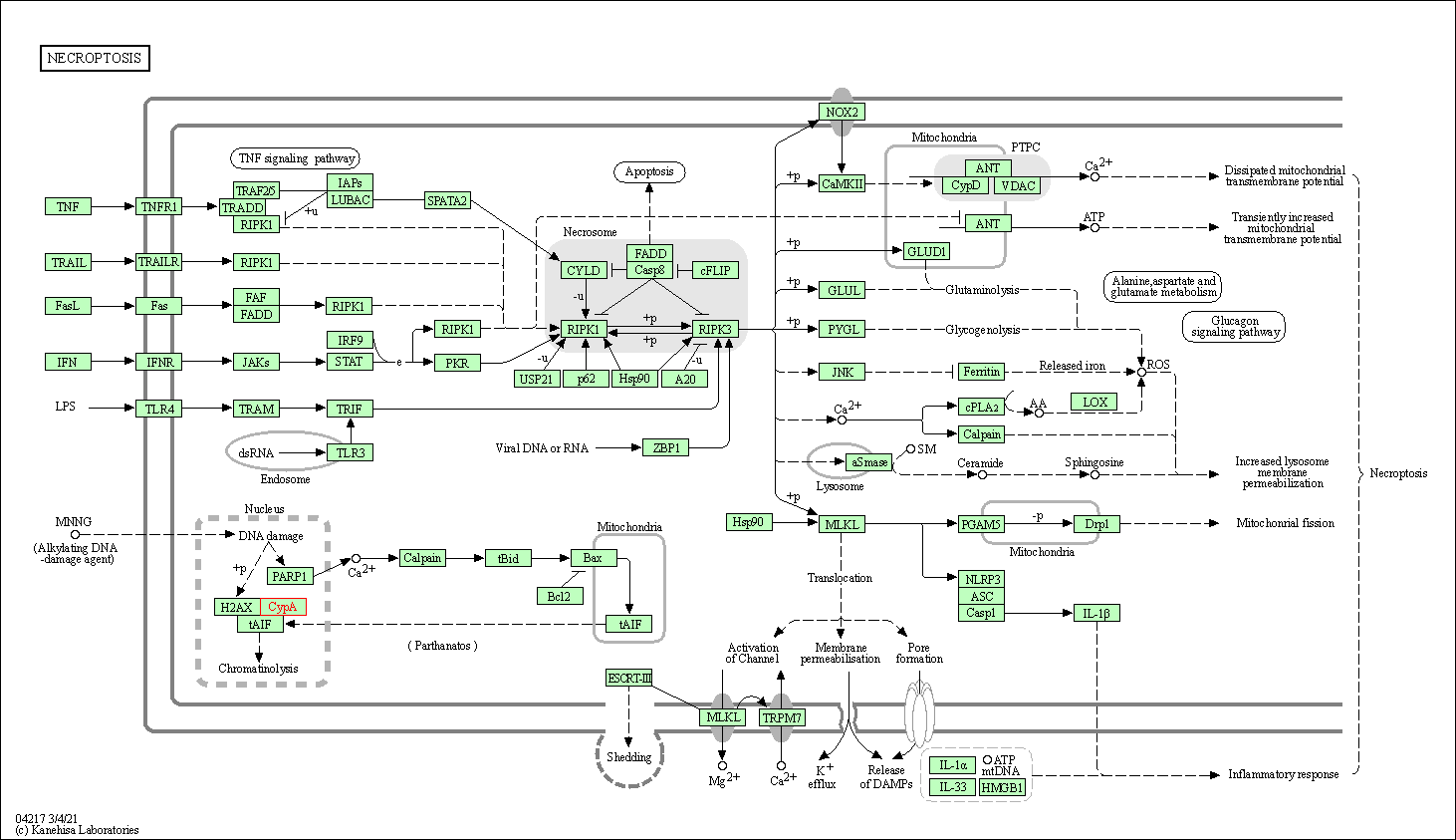Target Information
| Target General Information | Top | |||||
|---|---|---|---|---|---|---|
| Target ID |
T47081
(Former ID: TTDS00323)
|
|||||
| Target Name |
Rotamase A (PPIA)
|
|||||
| Synonyms |
PPIA; Cyclophilin A; CyPA
Click to Show/Hide
|
|||||
| Gene Name |
PPIA
|
|||||
| Target Type |
Successful target
|
[1] | ||||
| Disease | [+] 1 Target-related Diseases | + | ||||
| 1 | Nutritional deficiency [ICD-11: 5B50-5B71] | |||||
| Function |
Ppiases accelerate the folding of proteins. It catalyzes the cis-trans isomerization of proline imidic peptide bonds in oligopeptides.
Click to Show/Hide
|
|||||
| BioChemical Class |
Cis-trans-isomerases
|
|||||
| UniProt ID | ||||||
| EC Number |
EC 5.2.1.8
|
|||||
| Sequence |
MVNPTVFFDIAVDGEPLGRVSFELFADKVPKTAENFRALSTGEKGFGYKGSCFHRIIPGF
MCQGGDFTRHNGTGGKSIYGEKFEDENFILKHTGPGILSMANAGPNTNGSQFFICTAKTE WLDGKHVVFGKVKEGMNIVEAMERFGSRNGKTSKKITIADCGQLE Click to Show/Hide
|
|||||
| 3D Structure | Click to Show 3D Structure of This Target | PDB | ||||
| Drugs and Modes of Action | Top | |||||
|---|---|---|---|---|---|---|
| Approved Drug(s) | [+] 1 Approved Drugs | + | ||||
| 1 | L-Proline | Drug Info | Approved | Malnutrition | [2], [3] | |
| Mode of Action | [+] 2 Modes of Action | + | ||||
| Binder | [+] 1 Binder drugs | + | ||||
| 1 | L-Proline | Drug Info | [1] | |||
| Inhibitor | [+] 5 Inhibitor drugs | + | ||||
| 1 | (3r)-1-Acetyl-3-Methylpiperidine | Drug Info | [4] | |||
| 2 | 1-(3-benzyloxy-pyridin-2-yl)-3-phenyl-urea | Drug Info | [5] | |||
| 3 | 3-[3-(3-benzyloxy-pyridin-2-yl)-ureido]-benzamide | Drug Info | [5] | |||
| 4 | 7-AMINO-4-METHYL-CHROMEN-2-ONE | Drug Info | [6] | |||
| 5 | Ethyl Oxo(Piperidin-1-Yl)Acetate | Drug Info | [6] | |||
| Cell-based Target Expression Variations | Top | |||||
|---|---|---|---|---|---|---|
| Cell-based Target Expression Variations | ||||||
| Drug Binding Sites of Target | Top | |||||
|---|---|---|---|---|---|---|
| Ligand Name: Amifampridine | Ligand Info | |||||
| Structure Description | Structure of cyclophilin A in complex with pyridine-3,4-diamine | PDB:5NOW | ||||
| Method | X-ray diffraction | Resolution | 1.48 Å | Mutation | No | [7] |
| PDB Sequence |
MVNPTVFFDI
10 AVDGEPLGRV20 SFELFADKVP30 KTAENFRALS40 TGEKGFGYKG50 SCFHRIIPGF 60 MCQGGDFTRH70 NGTGGKSIYG80 EKFEDENFIL90 KHTGPGILSM100 ANAGPNTNGS 110 QFFICTAKTE120 WLDGKHVVFG130 KVKEGMNIVE140 AMERFGSRNG150 KTSKKITIAD 160 CGQLE
|
|||||
|
|
||||||
| Ligand Name: L-alanine | Ligand Info | |||||
| Structure Description | CYCLOPHILIN A COMPLEXED WITH DIPEPTIDE ALA-PRO | PDB:2CYH | ||||
| Method | X-ray diffraction | Resolution | 1.64 Å | Mutation | No | [8] |
| PDB Sequence |
VNPTVFFDIA
11 VDGEPLGRVS21 FELFADKVPK31 TAENFRALST41 GEKGFGYKGS51 CFHRIIPGFM 61 CQGGDFTRHN71 GTGGKSIYGE81 KFEDENFILK91 HTGPGILSMA101 NAGPNTNGSQ 111 FFICTAKTEW121 LDGKHVVFGK131 VKEGMNIVEA141 MERFGSRNGK151 TSKKITIADC 161 GQLE
|
|||||
|
|
||||||
| Click to View More Binding Site Information of This Target with Different Ligands | ||||||
| Different Human System Profiles of Target | Top |
|---|---|
|
Human Similarity Proteins
of target is determined by comparing the sequence similarity of all human proteins with the target based on BLAST. The similarity proteins for a target are defined as the proteins with E-value < 0.005 and outside the protein families of the target.
A target that has fewer human similarity proteins outside its family is commonly regarded to possess a greater capacity to avoid undesired interactions and thus increase the possibility of finding successful drugs
(Brief Bioinform, 21: 649-662, 2020).
Human Tissue Distribution
of target is determined from a proteomics study that quantified more than 12,000 genes across 32 normal human tissues. Tissue Specificity (TS) score was used to define the enrichment of target across tissues.
The distribution of targets among different tissues or organs need to be taken into consideration when assessing the target druggability, as it is generally accepted that the wider the target distribution, the greater the concern over potential adverse effects
(Nat Rev Drug Discov, 20: 64-81, 2021).
Human Pathway Affiliation
of target is determined by the life-essential pathways provided on KEGG database. The target-affiliated pathways were defined based on the following two criteria (a) the pathways of the studied target should be life-essential for both healthy individuals and patients, and (b) the studied target should occupy an upstream position in the pathways and therefore had the ability to regulate biological function.
Targets involved in a fewer pathways have greater likelihood to be successfully developed, while those associated with more human pathways increase the chance of undesirable interferences with other human processes
(Pharmacol Rev, 58: 259-279, 2006).
Biological Network Descriptors
of target is determined based on a human protein-protein interactions (PPI) network consisting of 9,309 proteins and 52,713 PPIs, which were with a high confidence score of ≥ 0.95 collected from STRING database.
The network properties of targets based on protein-protein interactions (PPIs) have been widely adopted for the assessment of target’s druggability. Proteins with high node degree tend to have a high impact on network function through multiple interactions, while proteins with high betweenness centrality are regarded to be central for communication in interaction networks and regulate the flow of signaling information
(Front Pharmacol, 9, 1245, 2018;
Curr Opin Struct Biol. 44:134-142, 2017).
Human Similarity Proteins
Human Tissue Distribution
Human Pathway Affiliation
Biological Network Descriptors
|
|
|
There is no similarity protein (E value < 0.005) for this target
|
|
Note:
If a protein has TS (tissue specficity) scores at least in one tissue >= 2.5, this protein is called tissue-enriched (including tissue-enriched-but-not-specific and tissue-specific). In the plots, the vertical lines are at thresholds 2.5 and 4.
|
| KEGG Pathway | Pathway ID | Affiliated Target | Pathway Map |
|---|---|---|---|
| Viral life cycle - HIV-1 | hsa03250 | Affiliated Target |

|
| Class: Genetic Information Processing => Information processing in viruses | Pathway Hierarchy | ||
| Necroptosis | hsa04217 | Affiliated Target |

|
| Class: Cellular Processes => Cell growth and death | Pathway Hierarchy | ||
| Degree | 6 | Degree centrality | 6.45E-04 | Betweenness centrality | 2.15E-04 |
|---|---|---|---|---|---|
| Closeness centrality | 2.07E-01 | Radiality | 1.36E+01 | Clustering coefficient | 1.33E-01 |
| Neighborhood connectivity | 1.53E+01 | Topological coefficient | 1.88E-01 | Eccentricity | 13 |
| Download | Click to Download the Full PPI Network of This Target | ||||
| Chemical Structure based Activity Landscape of Target | Top |
|---|---|
| Drug Property Profile of Target | Top | |
|---|---|---|
| (1) Molecular Weight (mw) based Drug Clustering | (2) Octanol/Water Partition Coefficient (xlogp) based Drug Clustering | |
|
|
||
| (3) Hydrogen Bond Donor Count (hbonddonor) based Drug Clustering | (4) Hydrogen Bond Acceptor Count (hbondacc) based Drug Clustering | |
|
|
||
| (5) Rotatable Bond Count (rotbonds) based Drug Clustering | (6) Topological Polar Surface Area (polararea) based Drug Clustering | |
|
|
||
| "RO5" indicates the cutoff set by lipinski's rule of five; "D123AB" colored in GREEN denotes the no violation of any cutoff in lipinski's rule of five; "D123AB" colored in PURPLE refers to the violation of only one cutoff in lipinski's rule of five; "D123AB" colored in BLACK represents the violation of more than one cutoffs in lipinski's rule of five | ||
| Target Poor or Non Binders | Top | |||||
|---|---|---|---|---|---|---|
| Target Poor or Non Binders | ||||||
| Target Regulators | Top | |||||
|---|---|---|---|---|---|---|
| Target-interacting Proteins | ||||||
| Target Affiliated Biological Pathways | Top | |||||
|---|---|---|---|---|---|---|
| Reactome | [+] 11 Reactome Pathways | + | ||||
| 1 | Platelet degranulation | |||||
| 2 | Uncoating of the HIV Virion | |||||
| 3 | Budding and maturation of HIV virion | |||||
| 4 | Integration of provirus | |||||
| 5 | Early Phase of HIV Life Cycle | |||||
| 6 | Minus-strand DNA synthesis | |||||
| 7 | Plus-strand DNA synthesis | |||||
| 8 | Binding and entry of HIV virion | |||||
| 9 | Assembly Of The HIV Virion | |||||
| 10 | APOBEC3G mediated resistance to HIV-1 infection | |||||
| 11 | Basigin interactions | |||||
| WikiPathways | [+] 5 WikiPathways | + | ||||
| 1 | Signaling by the B Cell Receptor (BCR) | |||||
| 2 | Host Interactions of HIV factors | |||||
| 3 | HIV Life Cycle | |||||
| 4 | JAK/STAT | |||||
| 5 | Cell surface interactions at the vascular wall | |||||
| References | Top | |||||
|---|---|---|---|---|---|---|
| REF 1 | Mechanistic insight into the role of transition-state stabilization in cyclophilin A. J Am Chem Soc. 2009 Jan 14;131(1):147-52. | |||||
| REF 2 | URL: http://www.guidetopharmacology.org Nucleic Acids Res. 2015 Oct 12. pii: gkv1037. The IUPHAR/BPS Guide to PHARMACOLOGY in 2016: towards curated quantitative interactions between 1300 protein targets and 6000 ligands. (Ligand id: 3314). | |||||
| REF 3 | Escherichia coli cyclophilin B binds a highly distorted form of trans-prolyl peptide isomer. Eur J Biochem. 2004 Sep;271(18):3794-803. | |||||
| REF 4 | How many drug targets are there Nat Rev Drug Discov. 2006 Dec;5(12):993-6. | |||||
| REF 5 | Structure-based design, synthesis, and biological evaluation of novel inhibitors of human cyclophilin A. J Med Chem. 2006 Feb 9;49(3):900-10. | |||||
| REF 6 | The Protein Data Bank. Nucleic Acids Res. 2000 Jan 1;28(1):235-42. | |||||
| REF 7 | Pushing the Limits of Detection of Weak Binding Using Fragment-Based Drug Discovery: Identification of New Cyclophilin Binders. J Mol Biol. 2017 Aug 4;429(16):2556-2570. | |||||
| REF 8 | Mechanistic implication of crystal structures of the cyclophilin-dipeptide complexes. Biochemistry. 1996 Jun 11;35(23):7362-8. | |||||
If You Find Any Error in Data or Bug in Web Service, Please Kindly Report It to Dr. Zhou and Dr. Zhang.

